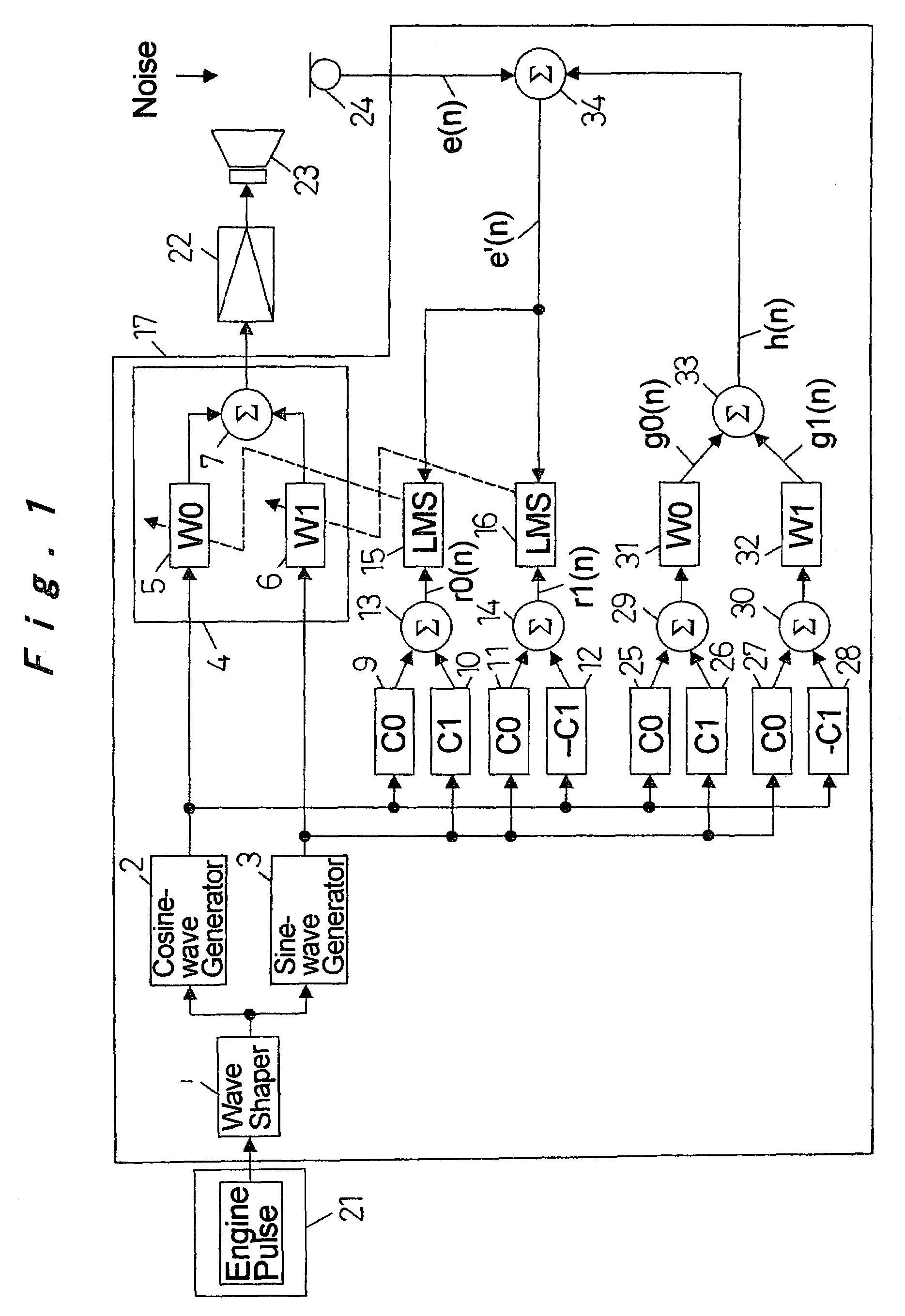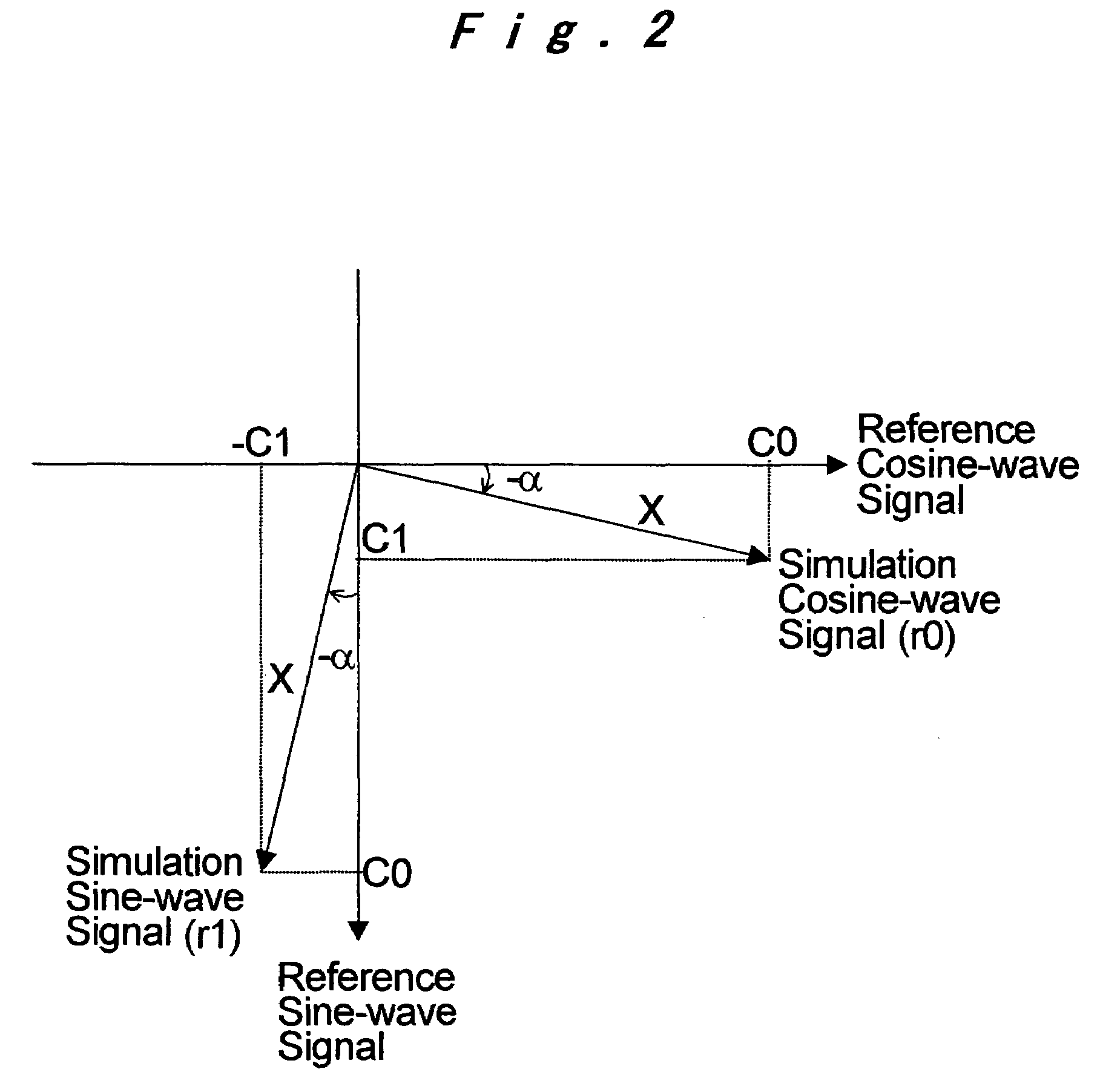Active noise control system
a technology of active noise control and control system, which is applied in the direction of active noise control, transportation and packaging, instruments, etc., can solve the problems of unstable operation of adaptive notch filter, confined engine noise that is noticeable periodicity, and resonance to occur in the passenger compartment, so as to prevent overcompensation, suppress divergence, and ideal noise reduction
- Summary
- Abstract
- Description
- Claims
- Application Information
AI Technical Summary
Benefits of technology
Problems solved by technology
Method used
Image
Examples
first embodiment
[0030]Now, the present invention will be explained below in more detail with reference to the accompanying drawings in accordance with the embodiments. In the drawings, the same components as those of the conventional active noise control system described in relation to the related art are indicated by the like reference symbols. By way of example, the present invention will be described in accordance with an active noise control system incorporated into a vehicle to reduce a vibrational noise in the passenger compartment caused by the operation of the engine.
[0031]FIG. 1 illustrates in a block diagram form the configuration of an active noise control system according to the first embodiment. Referring to FIG. 1, with an engine 21 being a noise source that generates a problematic noise, the active noise control system operates to reduce a periodic vibrational noise radiated by the engine 21.
[0032]An engine pulse or an electric signal synchronous with the rotation of the engine 21 is...
second embodiment
[0059]In accordance with the aforementioned first embodiment, described was that the added signal of the compensated signal “h” and the output signal (error signal “e”) from the microphone 24 is used in an adaptive control algorithm to update the filter coefficients W0 and W1 of the adaptive notch filter 4, thereby suppressing overcompensation and providing enhanced control stability. In the second embodiment, a description will be further made to a technique for controlling the amount of suppression of overcompensation.
[0060]FIG. 7 illustrates in a block diagram form the configuration of an active noise control system according to the second embodiment. In the figure, the same components as those of the active noise control system shown in the first embodiment are indicated by the like reference symbols.
[0061]FIG. 7 is different from FIG. 1 in that the compensated signal generator means is provided with a coefficient multiplier 35. With this arrangement, the compensated signal “h” ...
third embodiment
[0070]FIG. 9 illustrates in a block diagram form the configuration of an active noise control system according to the third embodiment. In the figure, the same components as those of the active noise control systems shown in the first and second embodiments are indicated by the like reference symbols.
[0071]FIG. 9 is different from FIG. 7 in that the compensated signal generator means is provided with an output control portion 36. With this arrangement, an output signal K·h from the coefficient multiplier 35 is supplied to the output control portion 36. The output control portion 36 includes a storage area for storing the values of the filter coefficient W0 of the first one-tap adaptive filter 5 each time the filter coefficient W0 is updated during a predetermined interval from a previous to the present point in time (e.g., an interval during which the filter coefficient is updated 20 times). The output control portion 36 calculates a cumulative amount of the changes. Similarly, the ...
PUM
 Login to View More
Login to View More Abstract
Description
Claims
Application Information
 Login to View More
Login to View More - R&D
- Intellectual Property
- Life Sciences
- Materials
- Tech Scout
- Unparalleled Data Quality
- Higher Quality Content
- 60% Fewer Hallucinations
Browse by: Latest US Patents, China's latest patents, Technical Efficacy Thesaurus, Application Domain, Technology Topic, Popular Technical Reports.
© 2025 PatSnap. All rights reserved.Legal|Privacy policy|Modern Slavery Act Transparency Statement|Sitemap|About US| Contact US: help@patsnap.com



